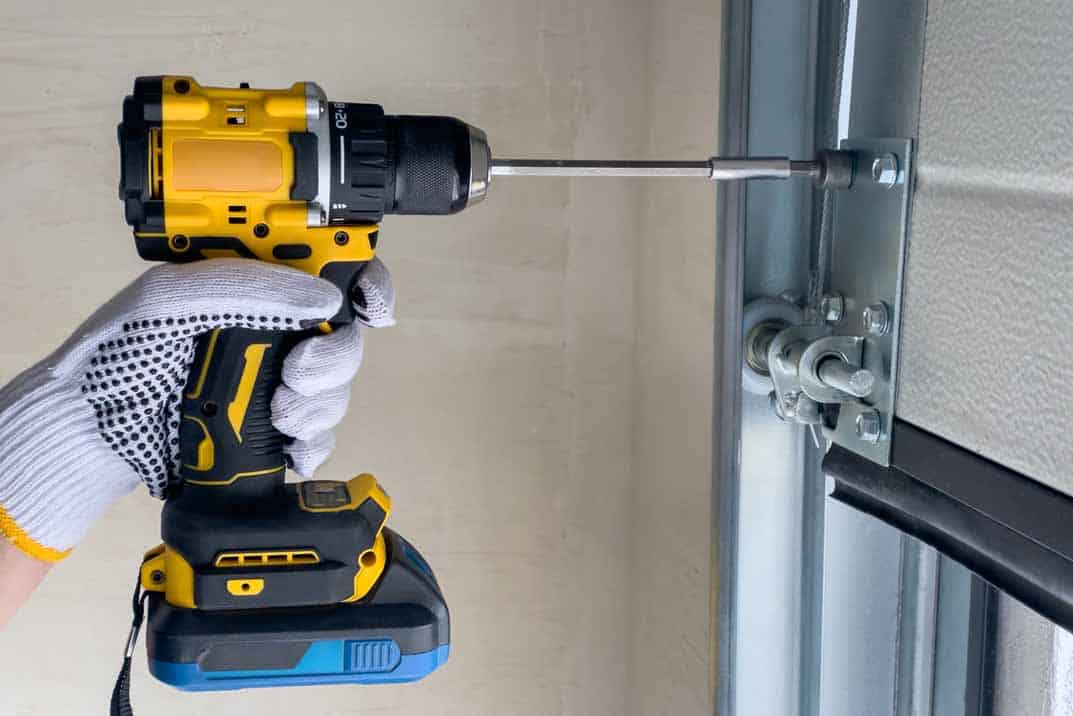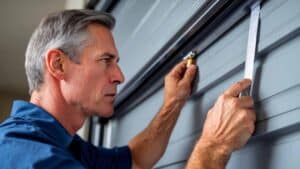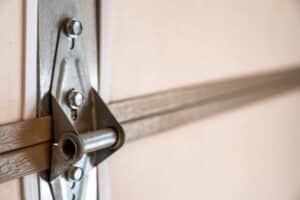Topics Covered:
Keeping your garage door in peak condition doesn’t necessarily require a lot of time or fancy equipment—especially when it comes to inspecting your hinges. In fact, a quick, methodical check every month or two can catch minor issues before they escalate into major repairs.
In this detailed guide, we’ll walk you through a simple step-by-step process to inspect your garage door hinges like a seasoned technician. Whether you’re a DIY enthusiast or just want to keep tabs on your door’s health, this tutorial is for you.
1. Gather Your Tools
Before you start, make sure you have:
- Work Gloves: Protects your hands from sharp edges or rust.
- Flashlight: To spot hidden cracks, rust, or other damage.
- Step Ladder: For reaching higher hinges safely.
- Protective Eyewear: Rust or debris can flake off when you touch hinges.
- Rag or Cloth: For wiping away dirt or grease.
Once you’ve got everything ready, choose a time when the garage is well-lit and the door is closed. This allows you to inspect each hinge without risking the door moving unexpectedly.
2. Check the Surroundings
Start by examining the general area around each hinge. Look for:
- Loose Debris: Leaves, dirt, or small objects that might wedge into hinge points.
- Signs of Moisture: Water stains or rust streaks on the door panels or the floor beneath.
- Dents or Impact Marks: A clue that something has collided with the door, potentially affecting hinge alignment.
Clearing away any debris and noting moisture issues sets the stage for a more focused hinge inspection.
3. Inspect Hinge Condition Visually
Now, shine your flashlight directly onto each hinge. Pay attention to:
- Rust or Corrosion: Even small rust patches can spread quickly, especially around hinge pins.
- Bent or Warped Metal: Compare the hinge shape to adjacent hinges to spot any irregularities.
- Cracks or Fractures: Hairline cracks in the hinge plate or door panel can worsen under repeated stress.
If you notice rust, consider whether it’s surface-level (which you might clean and treat) or deep (which could require professional intervention or hinge replacement).
4. Feel for Looseness or Excessive Play
Gently grasp each hinge and attempt a slight wiggle. While a tiny amount of movement can be normal, you shouldn’t feel the hinge rattling. Check the hinge plate where it attaches to the panel and the pivot point.
Red Flags:
- Bolts that shift easily with minimal pressure
- Hinge pin movement beyond what’s needed for pivoting
- Noticeable gaps between the hinge and door panel
Jot down which hinges feel loose. You might just need to tighten some bolts—but if the door panel around the bolt holes is cracked, that’s a bigger issue.
5. Listen for Unusual Sounds
Ask a family member or friend to operate the garage door while you stand close to the hinges (but remain safely clear of the moving door). Pay attention to any squeaks, rattles, or grinding noises specifically emanating from hinge areas.
What Different Noises May Mean:
- Squeaking: Possibly dryness; a dab of lubricant may help.
- Grinding: Could be rust or a bent hinge creating friction.
- Rattling: Often due to loose bolts or misaligned hinge plates.
Recording which hinge makes which noise helps you know where to focus your maintenance efforts.
6. Test the Bolt Tightness
Using a properly sized wrench or socket set, gently test each bolt. If it turns with little resistance, it’s too loose. But don’t overtighten—you can strip the threads or damage the door panel.
Pro Tip: If a bolt spins endlessly or doesn’t seem to tighten, the threads in the panel might be damaged. You’ll likely need a larger screw, a new fastener insert, or professional repair to restore stability.
7. Check for Panel Alignment
Observe how the door panels meet at the hinges. They should form a uniform seam with no gaps or obvious height differences.
Look for:
- Daylight Seeping Through: Indicates a possible hinge or panel warping issue.
- Uneven Seams: Panels not lining up can be a sign of hinge stress or older damage.
If you see misalignment, the hinges may be bent, or the door track and rollers could be causing undue strain on certain hinges.
8. Evaluate the Hinge Number or Type
Many garage door hinges have a stamped number (H1, H2, H3, etc.). Make sure each hinge is in the correct location. Sometimes, a previous owner or amateur repair job might have mixed them up. If the hinge numbers are inconsistent, consult your door’s manual or a pro to confirm the correct placement.
Using the right hinge in the right position ensures the door remains properly balanced and moves smoothly.
9. Clean and Lubricate
After you’ve noted any issues, give your hinges a little love:
- Wipe Down: Use a cloth to remove dirt, grime, or rust flakes.
- Lubricate Pivot Points: A silicone or lithium-based garage door lubricant works best. Avoid WD-40, which can strip existing lubricants and attract dust.
- Remove Excess Lubricant: Wipe away drips to avoid dust buildup.
This step is crucial even if you plan to do more extensive repairs soon. A little lubrication can prevent further damage in the meantime.
10. Document Your Findings
It might sound a bit formal, but taking notes or snapping photos during the inspection can be immensely helpful. You’ll have a record of:
- Which hinges showed signs of rust
- Any bolts that needed consistent tightening
- Noises and issues unique to specific hinges
If you later decide to hire a professional, this information can save time—and possibly money—by pointing them directly to problem areas.
11. Determine Next Steps
Once your inspection is complete, you’ll have a clear sense of the hinge conditions. Possible actions include:
- Minor Upkeep: If you only found slight rust or dryness, lubrication and cleaning might suffice.
- Tightening Bolts: A quick fix if hinges are secure but slightly loose.
- Replacing Individual Hinges: If one or two are severely corroded or bent, consider swapping them out.
- Professional Evaluation: If you see major misalignment, cracked panels, or multiple failing hinges, it’s time for a pro’s expertise.
Remember, a small investment in a single hinge replacement can prevent the need for much costlier repairs down the road.
12. Scheduling Professional Tune-Ups
Even the most thorough DIY inspections can miss subtle signs of trouble. We recommend an annual or biannual professional tune-up, especially if you notice repeated problems with certain hinges. A seasoned technician can spot minute warping, misalignment, or wear patterns that might not be obvious to the untrained eye.
At RJ Garage Door Services, we integrate hinge checks into our standard maintenance routine. We also look at tracks, rollers, spring tension, and opener settings, giving you a full snapshot of your door’s health.
Bonus Tips: Extending Hinge Lifespan
Aside from regular inspections, you can prolong hinge life by:
- Using the Right Opener Force: Excessive force can strain hinges.
- Avoiding Harsh Chemicals: If you wash your driveway or garage floor with strong detergents, ensure they don’t splatter onto hinges.
- Watching for Weather Damage: In humid or coastal areas, choose corrosion-resistant hinges and reapply protective coatings if needed.
Final Thoughts
Inspecting your garage door hinges isn’t rocket science, but it does require a bit of diligence and basic know-how. A flashlight, some common sense, and the right approach can go a long way in spotting issues early. By following the steps in this guide, you’ll be able to differentiate between minor problems you can tackle yourself and bigger red flags that call for professional help.
Remember, the cost of a thorough inspection—both in time and effort—pales in comparison to dealing with a major hinge failure or door malfunction down the line. We hope this step-by-step approach empowers you to maintain a safer, smoother-operating garage door. And if you ever encounter something that’s beyond your comfort level, RJ Garage Door Services is always here to provide expert assistance and keep those hinges in prime condition.




